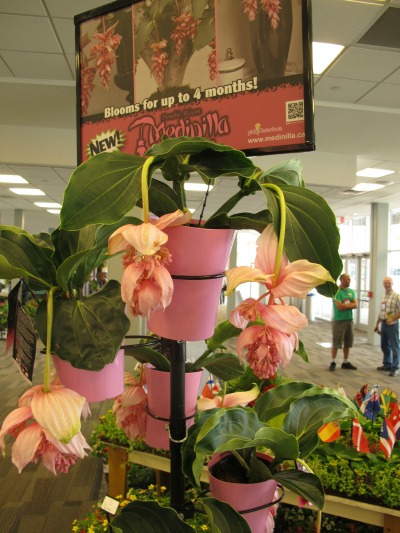
July 14, 2014, Columbus, OH — Numerous educational sessions and a busy
trade show – oh, and a little attention devoted to the FIFA World Cup
final game on Sunday – were among the early highlights of the inaugural
Cultivate conference and trade show.
July 14, 2014, Columbus, OH — Numerous educational sessions and a busy trade show – oh, and a little attention devoted to the FIFA World Cup final game on Sunday – were among the early highlights of the inaugural Cultivate conference and trade show.
Numerous booths had the World Cup game on large screen TVs, and large screens were also set up in the main foyer outside the trade show hall during Happy Hour.

|
| Newlux, of Surrey, B.C., is one of many companies featuring LED products. |
Some early personal observations include the large number of LED lighting displays and products, along with a large number of fairy garden companies.
Here are some highlights of the talks so far.
Breaking The Mold, by Garry Grueber of Cultivaris Europe
So-called “cross-over plants” can help growers extend their season, says Garry Grueber of Cultivaris Europe.
These plants, an intermediate between an annual and an perennial, offer the flowering power of an annual with the hardiness of a perennial for exceptional early season sales.
The plants are started in the fall in the greenhouse, before being subjected to a form of vernalization with several weeks of cooler temperatures during the short days and low light conditions.
In the spring, with increasing light levels and warmer temperatures, the plants will come into flower.
“Think of them as seasonal colour, not as annuals or perennials,” says Grueber.
Digiplexis, as one example, is one of the hottest crops to hit the market in many years. Consumers can’t buy enough of them.
'Illumination' Digiplexis was judged “Plant of the Year” at the 2012 Chelsea Flower Show. “It has non-stop flowering once vernalized,” says Grueber.
Social Media and Digital Roundtable Exchange
The Garden Writers Association has 1,800 members. Their goal is to help more people enjoy more plants.
Daniel Gasteiger is a social media expert and author.
If you’re going to reach younger consumers, Twitter is the best vehicle, he notes. “They’re constantly online,” he says. It’s how they like to communicate.

|
| Dr. Ann Chase was the featured speaker at a workshop at the BioWorks booth. She discussed, "How to Successfully Integrate Biological Controls Into A Disease Management Program." |
For overall gardening exposure, every Monday at 9 p.m., “#gardenchat” sessions are held over Twitter. The sessions attract hundreds of enthusiastic gardeners and specialists each week discussing the latest trends and challenges.
Twitter offers “obstacle-free engagement.” Use the search function “to find people who matter to you.”
If you’re starting out with social media, blogging is your best bet. Unlike Facebook, you own your blog site and can control how it is developed and accessed.
He also suggests using Tumblr.com and Google+. Since Google is the leading search engine, registering with Google+ makes sense.
Freelance writer, editor and blogger Teresa Woodard suggests blogs should be posted at least weekly, and be in the 300-word range, along with photos if available.
To get started, “define your purpose,” and “consider your audience.” That focus will be important in building readership.
To build content, it’s important to set an editorial calendar, invite guest bloggers, use hyperlinks and tag everything to make the site easily searchable.
“Blogging is more personal than newsletters,” she says. Include anecdotes of your own experiences where possible. “Have fun with it.”
Pre-selling and Extending the Retail Season, by Leslie Halleck of Halleck Horticultural LLC.
Halleck suggested retailers identify their sales seasons, and work on the strengths and weaknesses of each of them to drive more traffic.
“We are all looking for ways to break the ‘seasonal curse’ of being a garden centre and keep customer traffic moving during slow times of the year.
When she managed a garden centre in Texas, her seasons included: “Winter,” of mid-December through early February; “Early Spring,” of early February through early/mid-March; “Spring, of early/mid-March through May; “Early Summer,” being the month of June; “Summer,” of July and August; “Fall,” of September through mid-November; “Holiday,” from mid-November through mid-December.
Identify the top-five sellers for each key season, and set a goal of boosting sales by five to 10 per cent for each of them. The key is to begin promoting them as early as possible.
And just as importantly, “identify the slowest turning items for each key season and dump them.”
She suggested opening an hour or two earlier on Saturdays and offering special discounts during those hours.
Extending store hours on some days can be designated the “happy hour” to assist customers dropping by to browse and shop after work.
 |
| Medinilla Magnifica, from Northend Gardens in St. Catharines, has been a show stopper near the main entranceway. |
PREVIEWING TODAY’S HIGHLIGHTS
Today’s highlights include a tour and reception at the Ohio State University trials gardens (weather permitted – the skies are threatening this morning – and tonight’s Green Profit/Red Fox Young Retailer Award ceremonies.
Debbie Foisey, owner of Deb’s Greenhouse in Wildwood, Alberta, is a finalist in this year’s Retailer Award program. She is one of three finalists in the program.
Foisy, 33, the energetic manager of The Greenhouse Marketing Forum, is also the president of the Alberta Greenhouse Growers Association.

|
| Delegates took breaks to catch up on Sunday's World Cup final. |
Print this page